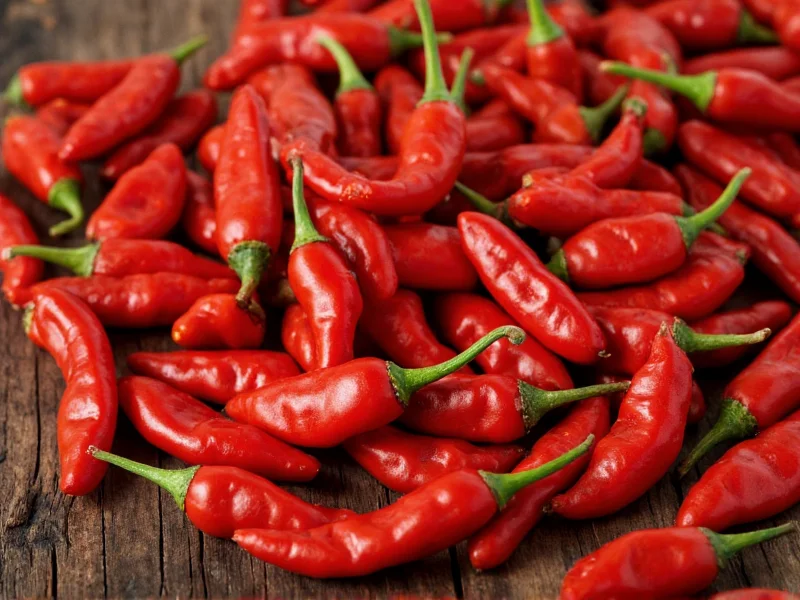Aleppo pepper, also known as Halaby pepper, originates from Syria and Turkey and has become a staple in Middle Eastern cuisine. Unlike many hot peppers that deliver immediate, intense heat, Aleppo pepper provides a gradual warmth that enhances dishes without overwhelming them. This unique heat profile makes it versatile for both novice and experienced cooks who want to add complexity to their recipes.
Understanding Aleppo Pepper's Heat Level
The Scoville scale measures chili pepper heat by determining capsaicin concentration. Aleppo pepper sits comfortably in the medium-heat range, offering enough kick to be interesting without causing discomfort for most palates. Its heat builds slowly rather than hitting immediately, allowing the nuanced flavors to shine through before the warmth becomes noticeable.
| Pepper Type | Scoville Heat Units (SHU) | Heat Comparison to Aleppo |
|---|---|---|
| Aleppo Pepper | 10,000-30,000 | Baseline |
| Cayenne Pepper | 30,000-50,000 | 1.5-2x hotter |
| Tabasco Pepper | 30,000-50,000 | 1.5-2x hotter |
| Serrano Pepper | 10,000-23,000 | Similar to slightly milder |
| Red Pepper Flakes | 15,000-25,000 | Slightly milder |
| Sweet Paprika | 0-500 | Significantly milder |
| Chipotle Powder | 2,500-8,000 | Much milder |
Flavor Profile Beyond the Heat
What sets Aleppo pepper apart from other medium-heat chilies is its complex flavor profile. While measuring 10,000-30,000 SHU confirms is Aleppo pepper hot enough to register as spicy, its culinary value extends far beyond simple heat. The pepper undergoes a specific curing process where ripe peppers are dried in the sun, then packed in olive oil and salt. This traditional preparation method develops its characteristic:
- Fruity undertones reminiscent of dried cherries
- Subtle tanginess similar to tamarind
- Natural saltiness that reduces the need for additional salt
- Earthy depth that enhances roasted vegetables and meats
Culinary Applications of Aleppo Pepper
Chefs and home cooks value Aleppo pepper for its ability to add dimension to dishes without dominating them. Understanding how hot is Aleppo pepper compared to cayenne helps determine appropriate substitutions. While cayenne delivers straightforward heat, Aleppo pepper contributes both warmth and flavor complexity.
Common uses include:
- As a finishing spice sprinkled over hummus, avocado toast, or eggs
- In marinades for chicken, lamb, or fish where its gradual heat penetrates without burning
- Blended into olive oil for dipping bread
- Added to tomato-based sauces to enhance depth without overwhelming acidity
- Mixed into salad dressings for subtle warmth
Substituting Aleppo Pepper
When determining is Aleppo pepper hotter than paprika, the answer is clearly yes—significantly so. If you need a substitute:
- For similar heat and flavor: Combine sweet paprika with a pinch of cayenne (use a 3:1 ratio)
- For milder alternative: Use smoked paprika alone
- For closer heat level: Crushed red pepper flakes with a dash of lemon zest
- For authentic flavor profile: Try Maras pepper from Turkey, which has nearly identical characteristics
When substituting, remember that Aleppo pepper Scoville units place it in a specific heat category—too much cayenne will create excessive heat without the nuanced flavor.
Storage and Quality Considerations
To maintain Aleppo pepper's distinctive flavor and moderate heat level, proper storage is essential. Exposure to light, air, and moisture degrades both the color and heat compounds. Store in an airtight container away from direct sunlight, and use within 6-12 months for optimal flavor. High-quality Aleppo pepper should have a deep burgundy color and emit a faint fruity aroma when opened.
Who Should Use Aleppo Pepper?
Aleppo pepper works well for:
- Cooking enthusiasts seeking to expand beyond basic red pepper flakes
- Those who enjoy mild alternative to Aleppo pepper options but want more complexity than paprika
- People who appreciate gradual heat development rather than immediate burn
- Chefs creating dishes where spice should complement rather than dominate
Its moderate heat level makes it accessible to those building tolerance to spicier foods while still offering enough warmth to satisfy heat seekers when used generously.
How does Aleppo pepper compare to cayenne in heat?
Aleppo pepper is significantly milder than cayenne. While Aleppo measures 10,000-30,000 Scoville units, cayenne ranges from 30,000-50,000 units. This makes cayenne approximately 1.5-2 times hotter than Aleppo pepper, with a sharper, more immediate heat compared to Aleppo's gradual warmth.
Can I substitute paprika for Aleppo pepper?
You can substitute paprika for Aleppo pepper, but note that sweet paprika has almost no heat (0-500 SHU) compared to Aleppo's 10,000-30,000 SHU. For closer results, mix 3 parts sweet paprika with 1 part cayenne pepper to approximate both the heat level and flavor complexity of Aleppo pepper.
Why is Aleppo pepper considered moderately hot?
Aleppo pepper is considered moderately hot because it falls in the 10,000-30,000 Scoville range, which is substantial but not extreme. Its heat builds gradually rather than hitting immediately, and it's balanced by distinctive fruity, tangy flavors that prevent the heat from becoming overwhelming. This places it in the same general heat category as serrano peppers but milder than cayenne or tabasco.
Does the heat of Aleppo pepper change when cooked?
Yes, cooking affects Aleppo pepper's heat perception. When added early in cooking, some capsaicin breaks down, resulting in milder heat but more integrated flavor. When used as a finishing spice, it delivers more noticeable heat. The gradual heat development characteristic of Aleppo pepper becomes even more pronounced when cooked, making it excellent for dishes that benefit from building warmth.
Is Aleppo pepper suitable for people sensitive to spicy foods?
Aleppo pepper can work for those with mild spice sensitivity due to its gradual heat development and balanced flavor profile. Start with small amounts (1/8 to 1/4 teaspoon) to assess tolerance. Its heat is significantly milder than many common hot peppers, and the fruity notes help offset the spiciness. However, those with extreme sensitivity may still find it too hot and might prefer smoked paprika as a milder alternative.











 浙公网安备
33010002000092号
浙公网安备
33010002000092号 浙B2-20120091-4
浙B2-20120091-4